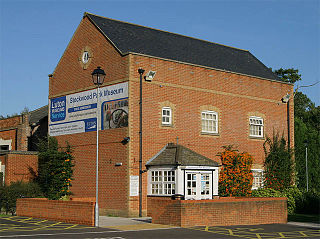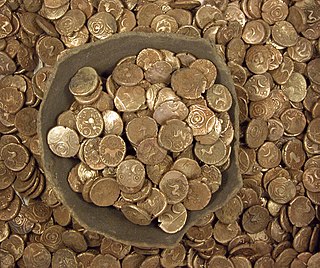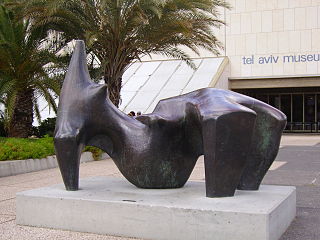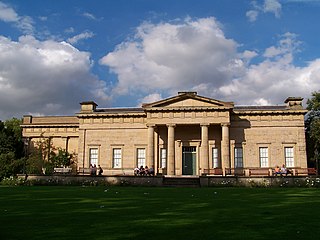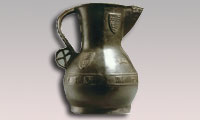
The Wenlok jug or Wenlock jug is a rare surviving example of an English bronze jug from the 15th century, with great significance for the study of bronze working in medieval England. Only two similar jugs are known in the UK. The Wenlok jug is the smallest of the three, but bears the earliest maker's mark for the English founder - possibly a bell founder - who cast it. The other examples are the Asante Ewer, which retains its lid and is held by the British Museum having been found at Kumai in the Gold Coast in 1896 during the Anglo-Ashanti wars, and the Robinson jug, which was found in a farmhouse in Norfolk in the 1879 and is now in the collection of the Victoria & Albert Museum. All bear inscriptions in English and were made from leaded bronze, an alloy of copper, tin and lead, cast in a two-part mould in a similar manner using bronze spacers to separate the inner and outer moulds, with similar decorative motifs.

The British Museum, in the Bloomsbury area of London, United Kingdom, is a public institution dedicated to human history, art and culture. Its permanent collection of some eight million works is among the largest and most comprehensive in existence, having been widely sourced during the era of the British Empire. It documents the story of human culture from its beginnings to the present. It was the first public national museum in the world.

The Gold Coast was a British colony on the Gulf of Guinea in west Africa from 1867 to its independence as the nation of Ghana in 1957.
The Anglo-Ashanti Wars were a series of five conflicts between the Ashanti Empire, in the Akan interior of the Gold Coast, and the British Empire and British-allied African states that took place between 1824 and 1901. The wars were mainly due to Ashanti attempts to establish strong control over the coastal areas of what is now Ghana. Coastal peoples, such as the Fante and the inhabitants of Accra, who were chiefly Ga, came to rely on British protection against Ashanti incursions.
The Wenlok jug stands 31.5 centimetres (12.4 in) high and weighs 6.1 kilograms (13 lb). It is decorated with the words "My Lord Wenlok", and several heraldic emblems, including the Royal Arms of England used from 1340 to 1405, and the three crowns of East Anglia associated with St Edmund (who was King of East Anglia) and St Etheldreda. Hinges indicate a lid was once present, but it is now missing. It is thought to have been made for William Wenlock (d. 1391), Canon of St Paul's Cathedral from 1362, Archdeacon of Rochester from 1376, and Canon of the King's Chapel, Westminster in 1381, who is buried at St Mary's Church, Luton, or his great-nephew John Wenlock, 1st Baron Wenlock, whose brick-built manor house Someries Castle is near Luton.

The Royal Arms of England are the arms first adopted in a fixed form at the start of the age of heraldry as personal arms by the Plantagenet kings who ruled England from 1154. In the popular mind they have come to symbolise the nation of England, although according to heraldic usage nations do not bear arms, only persons and corporations do. The blazon of the Arms of Plantagenet is: Gules, three lions passant guardant in pale or armed and langued azure, signifying three identical gold lions with blue tongues and claws, walking past but facing the observer, arranged in a column on a red background. Although the tincture azure of tongue and claws is not cited in many blazons, they are historically a distinguishing feature of the Arms of England. This coat, designed in the High Middle Ages, has been variously combined with those of the Kings of France, Scotland, a symbol of Ireland, the House of Nassau and the Kingdom of Hanover, according to dynastic and other political changes occurring in England, but has not altered since it took a fixed form in the reign of Richard I (1189–1199), the second Plantagenet king.

Three Crowns is a national emblem of Sweden, present in the coat of arms of Sweden, and composed of three yellow or gilded coronets ordered two above and one below, placed on a blue background.

East Anglia is a geographical area in the East of England. The area included has varied but the legally defined NUTS 2 statistical unit comprises the counties of Norfolk, Suffolk and Cambridgeshire, including the City of Peterborough unitary authority area. The name derives from the Anglo-Saxon kingdom of the East Angles, a tribe whose name originated in Anglia, northern Germany.
By 1831 it was in the collection of Thomas William Fermor, 4th Earl of Pomfret, possibly acquired by antiquarian Henrietta Louisa Fermor.
Henrietta Louisa Fermor, Countess of Pomfret, was an English letter writer.
The jug was sold by Alexander Fermor-Hesketh, 3rd Baron Hesketh at Sotheby's in 2005 along with other articles from Easton Neston in Northamptonshire. It reached £568,000, six times the top auctioneer's estimate of £60,000 to £80,000. The Metropolitan Museum of Art in New York tried to buy the jug from the buyer, but a temporary export ban in October 2005 allowed Luton Museum to raise £750,000 to match the price and acquire it instead, funded by £137,500 from the National Art Collections Fund, £500,000 from the National Heritage Memorial Fund, and donations from the Headley Trust, the Pilgrim Trust, the Worshipful Company of Founders, the Friends of Luton Museums, and others.
Thomas Alexander Fermor-Hesketh, 3rd Baron Hesketh, KBE, PC, is a British peer and UK Independence Party politician.
Sotheby's is a British-founded American multinational corporation headquartered in New York City. One of the world's largest brokers of fine and decorative art, jewelry, real estate, and collectibles, Sotheby's operation is divided into three segments: auction, finance, and dealer. The company's services range from corporate art services to private sales. It is named after one of its cofounders, John Sotheby.

Easton Neston is a large grade I listed country house in the parish of Easton Neston near Towcester in Northamptonshire, England. It was built by William Fermor, 1st Baron Leominster (1648–1711), in the Baroque style to the design of the architect Nicholas Hawksmoor. Easton Neston is thought to be the only mansion which was solely the work of Hawksmoor. From about 1700, after the completion of Easton Neston, Hawksmoor worked with Sir John Vanbrugh on many buildings, including Castle Howard and Blenheim Palace, and often provided technical knowledge to the less qualified Vanbrugh. Hawksmoor's work was always more classically severe than Vanbrugh's. However, Easton Neston predates this partnership by some six years.
The jug was displayed in Luton at Wardown Park Museum and then at the Stockwood Discovery Centre in Stockwood Park. It was stolen from a high-security cabinet at Stockwood Discovery Centre on 12 May 2012. After appearing on the BBC's Crimewatch programme, the jug was recovered in Tadworth, Surrey in September 2012.

Wardown Park Museum, formerly the Luton Museum & Art Gallery in Luton, is housed in a large Victorian mansion in Wardown Park on the outskirts of the town centre. The museum collection focuses on the traditional crafts of Bedfordshire, notably lace-making and hat-making. There are samples of Bedfordshire lace from as early as the 17th century.

Stockwood Park is a large urban park in Luton, Bedfordshire, in the Farley Hill estate. With period formal gardens, leading crafts museums, Stockwood Park Rugby Club and extensive golfing facilities, it is about 100 hectares in area.

Crimewatch is a British television programme produced by the BBC, that reconstructs major unsolved crimes in order to gain information from the public which may assist in solving the case. The programme was originally broadcast once a month on BBC One, although in more recent years it was usually broadcast roughly once every two months.
It has also been suggested [1] that all three ewers were made in, or near, Bruges during the first week of July 1468, and given by the Charles the Bold, Count of Burgundy, to the travelling companions of his bride, Margaret of York (King Edward IV's sister). Her companions were Sir Anthony Woodville (Asante Ewer), the Duchess of Norfolk (the Robinson Jug), and Lord John Wenlock (the Wenlock Jug). The English texts were devised by the new countess, and the out-of-date coat of arms were in the household of the count's aunt, who had married the Duke of Bedford in 1423. The three jugs/ewers would therefore be examples of mid-fifteenth century Burgundian workmanship.

Bruges is the capital and largest city of the province of West Flanders in the Flemish Region of Belgium, in the northwest of the country.

Charles the Bold, baptised Charles Martin, was Duke of Burgundy from 1467 to 1477. He was the last Duke of Burgundy from the House of Valois.
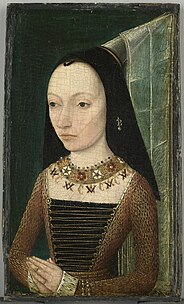
Margaret of York —also by marriage known as Margaret of Burgundy—was Duchess of Burgundy as the third wife of Charles the Bold and acted as a protector of the duchy after his death. She was a daughter of Richard, 3rd Duke of York, and Cecily Neville, and the sister of two kings of England, Edward IV and Richard III. She was born at Fotheringhay Castle, Northamptonshire, in the Kingdom of England, and she died at Mechelen in the Low Countries.





